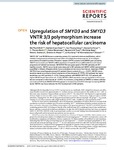Upregulation of SMYD3 and SMYD3 VNTR 3/3 polymorphism increase the risk of hepatocellular carcinoma
Thanh Binh, Mai
Xuan Hoan, Nghiem
Phuong Giang, Dao
Van Tong, Hoang
Bock, Claus-Thomas
Wedemeyer, Heiner
Linh Toan, Nguyen
Hong Bang, Mai
Kremsner, Peter G.
Meyer, Christian G.
Huu Song, Le
Velavan, Thirumalaisamy P.
SMYD3 (SET and MYND domain-containing protein 3) is involved in histone modification, which initiates oncogenesis by activating transcription of multiple downstream genes. To investigate associations of variable numbers of tandem repeats (VNTR) variants in the SMYD3 gene promoter, SMYD3 serum levels and SMYD3 mRNA expression in hepatitis B virus (HBV) infection and clinical progression of related liver disease. SMYD3 VNTRs were genotyped in 756 HBV patients and 297 healthy controls. SMYD3 serum levels were measured in 293 patients and SMYD3 mRNA expression was quantified in 48 pairs of hepatocellular tumor and adjacent non-tumor liver tissues. Genotype SYMD3 VNTR 3/3 was more frequent among HCC patients than in controls (Padjusted = 0.037). SMYD3 serum levels increased according to clinical progression of liver diseases (P = 0.01); HCC patients had higher levels than non-HCC patients (P = 0.04). Among patients with SMYD3 VNTR 3/3, HCC patients had higher SMYD3 levels than others (P < 0.05). SMYD3 mRNA expression was up-regulated in HCC tumor tissues compared to other tissues (P = 0.008). In conclusion, upregulation of SMYD3 correlates with the occurrence of HCC and SMYD3 VNTR 3/3 appears to increase the risk of HCC through increasing SMYD3 levels. SMYD3 may be an indicator for HCC development in HBV patients.
Files in this item

